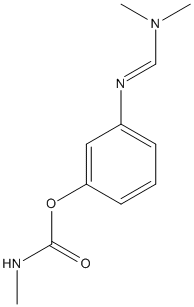Formetanate
General
Type : Insecticide,Carbamate
Chemical_Nomenclature : [3-(dimethylaminomethylideneamino)phenyl] N-methylcarbamate
Canonical SMILES : CNC(=O)OC1=CC=CC(=C1)N=CN(C)C
InChI : InChI=1S\/C11H15N3O2\/c1-12-11(15)16-10-6-4-5-9(7-10)13-8-14(2)3\/h4-8H,1-3H3,(H,12,15)
InChIKey : RMFNNCGOSPBBAD-UHFFFAOYSA-N
Other name(s) : Dicarzol,Formetanat,Caswell No. 465A,Formetanate [ANSI:BSI:ISO]
MW : 221.26
Formula : C11H15N3O2
CAS_number : 22259-30-9
PubChem : 31099
UniChem : RMFNNCGOSPBBAD-UHFFFAOYSA-N
IUPHAR :
Wikipedia : Formetanate

Target
References (8)
| Title : Formetanate toxicity and changes in antioxidant enzyme system of Apis mellifera larvae - Staron_2017_Environ.Sci.Pollut.Res.Int_24_14060 |
| Author(s) : Staron M , Sabo R , Sobekova A , Sabova L , Legath J , Lohajova L , Javorsky P |
| Ref : Environ Sci Pollut Res Int , 24 :14060 , 2017 |
| Abstract : Staron_2017_Environ.Sci.Pollut.Res.Int_24_14060 |
| ESTHER : Staron_2017_Environ.Sci.Pollut.Res.Int_24_14060 |
| PubMedSearch : Staron_2017_Environ.Sci.Pollut.Res.Int_24_14060 |
| PubMedID: 28409431 |
| Title : Esterase inhibition by synergists in the western flower thrips Frankliniella occidentalis - Lopez-Soler_2011_Pest.Manag.Sci_67_1549 |
| Author(s) : Lopez-Soler N , Cervera A , Quinto V , Abellan J , Bielza P , Martinez-Pardo R , Garcera MD |
| Ref : Pest Manag Sci , 67 :1549 , 2011 |
| Abstract : Lopez-Soler_2011_Pest.Manag.Sci_67_1549 |
| ESTHER : Lopez-Soler_2011_Pest.Manag.Sci_67_1549 |
| PubMedSearch : Lopez-Soler_2011_Pest.Manag.Sci_67_1549 |
| PubMedID: 21656898 |
| Title : Impact of production system on development of insecticide resistance in Frankliniella occidentalis (Thysanoptera: Thripidae) - Bielza_2008_J.Econ.Entomol_101_1685 |
| Author(s) : Bielza P , Quinto V , Gravalos C , Fernandez E , Abellan J |
| Ref : J Econ Entomol , 101 :1685 , 2008 |
| Abstract : Bielza_2008_J.Econ.Entomol_101_1685 |
| ESTHER : Bielza_2008_J.Econ.Entomol_101_1685 |
| PubMedSearch : Bielza_2008_J.Econ.Entomol_101_1685 |
| PubMedID: 18950052 |
| Title : Time course of cholinesterase inhibition in adult rats treated acutely with carbaryl, carbofuran, formetanate, methomyl, methiocarb, oxamyl or propoxur - Padilla_2007_Toxicol.Appl.Pharmacol_219_202 |
| Author(s) : Padilla S , Marshall RS , Hunter DL , Lowit A |
| Ref : Toxicol Appl Pharmacol , 219 :202 , 2007 |
| Abstract : Padilla_2007_Toxicol.Appl.Pharmacol_219_202 |
| ESTHER : Padilla_2007_Toxicol.Appl.Pharmacol_219_202 |
| PubMedSearch : Padilla_2007_Toxicol.Appl.Pharmacol_219_202 |
| PubMedID: 17197007 |
| Title : A method to determine precise benchmark doses for carbamate anticholinesterases - Lassiter_2007_Toxicol.Sci_96_154 |
| Author(s) : Lassiter TL , Brimijoin S |
| Ref : Toxicol Sci , 96 :154 , 2007 |
| Abstract : Lassiter_2007_Toxicol.Sci_96_154 |
| ESTHER : Lassiter_2007_Toxicol.Sci_96_154 |
| PubMedSearch : Lassiter_2007_Toxicol.Sci_96_154 |
| PubMedID: 17159234 |
| Title : Relative stability of formamidine and carbamate groups in the bifunctional pesticide formetanate hydrochloride - Divito_2007_J.Agric.Food.Chem_55_5377 |
| Author(s) : Divito CB , Davies S , Masoudi S , Muhoro CN |
| Ref : Journal of Agricultural and Food Chemistry , 55 :5377 , 2007 |
| Abstract : Divito_2007_J.Agric.Food.Chem_55_5377 |
| ESTHER : Divito_2007_J.Agric.Food.Chem_55_5377 |
| PubMedSearch : Divito_2007_J.Agric.Food.Chem_55_5377 |
| PubMedID: 17552536 |
| Title : Cholinergic involvement in the action of formetanate on operant behavior in rats - Moser_1987_Pharmacol.Biochem.Behav_26_119 |
| Author(s) : Moser VC , MacPhail RC |
| Ref : Pharmacol Biochem Behav , 26 :119 , 1987 |
| Abstract : Moser_1987_Pharmacol.Biochem.Behav_26_119 |
| ESTHER : Moser_1987_Pharmacol.Biochem.Behav_26_119 |
| PubMedSearch : Moser_1987_Pharmacol.Biochem.Behav_26_119 |
| PubMedID: 3562483 |
| Title : The effects of U-40481, demethylchlordimeform, and formetanate on calcium flux in the isolated rabbit aorta - Robinson_1980_Res.Commun.Chem.Pathol.Pharmacol_28_215 |
| Author(s) : Robinson CP , Pento JT |
| Ref : Res Commun Chem Pathol Pharmacol , 28 :215 , 1980 |
| Abstract : Robinson_1980_Res.Commun.Chem.Pathol.Pharmacol_28_215 |
| ESTHER : Robinson_1980_Res.Commun.Chem.Pathol.Pharmacol_28_215 |
| PubMedSearch : Robinson_1980_Res.Commun.Chem.Pathol.Pharmacol_28_215 |
| PubMedID: 6771843 |